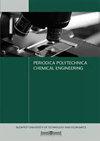The Effective Carbon Number of Chlorobenzenes
IF 1.8
4区 工程技术
Q3 ENGINEERING, CHEMICAL
引用次数: 1
Abstract
Detector response of 12 chlorobenzenes was investigated (mono-, di-, tri-, tetra-, penta-, and hexachlorobenzene, CBs) using flame ionization detector in a capillary gas chromatographic system. We determined the signal-reducing effect of the chlorine atom on the aromatic ring relative to the number of the chlorine substituents and expressed with the effective carbon number (ECN). Benzene was applied as a reference substance. Using the signal-modifying pattern of the chlorine atoms on the benzene's response, we developed an alternative calibration measurement method (CBs-ECN method) for the 12 CBs and compared it with classic calibration. The differences in the concentrations calculated by the two quantitative methods were under 4.5% for 11 CBs and 7% for one compound.Taking advantage of the opportunities provided by the CBs-ECN pattern it is not necessary to apply all of the 12 CBs but only one single component, the hexachlorobenzene for the calibration. With this simplification, the preparation of the calibration standards is faster, does not require purchasing all 12 CBs for each subsequent calibration, and the exposure to harm and expenses are reduced.氯苯的有效碳数
采用火焰电离检测器在毛细管气相色谱系统中对12种氯苯(一、二、三、四、五、六氯苯)的检测器响应进行了研究。我们用有效碳数(ECN)来表示氯原子对芳香环的信号还原作用。以苯为对照品。利用氯原子对苯响应的信号修饰模式,建立了12种苯的替代校准测量方法(CBs- ecn法),并与经典校准方法进行了比较。两种定量方法计算的浓度差异对11种CBs小于4.5%,对一种化合物小于7%。利用CBs- ecn模式提供的机会,不需要应用所有12个CBs,而只需应用一种单一成分,即六氯苯进行校准。通过这种简化,校准标准的编制速度更快,不需要为每次后续校准购买所有12个CBs,并且减少了暴露于危害和费用。
本文章由计算机程序翻译,如有差异,请以英文原文为准。
求助全文
约1分钟内获得全文
求助全文
来源期刊

Periodica Polytechnica Chemical Engineering
ENGINEERING, CHEMICAL-
CiteScore
3.10
自引率
7.70%
发文量
44
审稿时长
>12 weeks
期刊介绍:
The main scope of the journal is to publish original research articles in the wide field of chemical engineering including environmental and bioengineering.
 求助内容:
求助内容: 应助结果提醒方式:
应助结果提醒方式:


